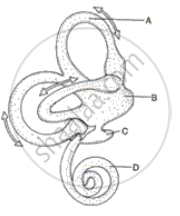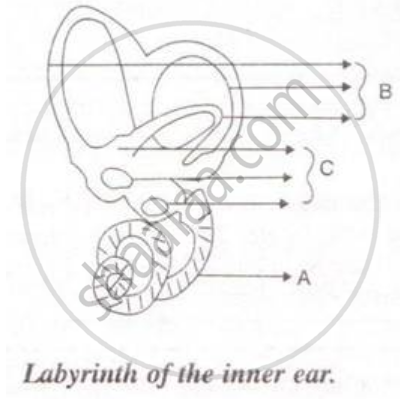Advertisements
Advertisements
प्रश्न
Explain the following:
Mechanism through which a sound produces a nerve impulse in the inner ear.
उत्तर
The pinna of the external ear collects the sound waves and directs them to the tympanic membrane (ear drum) via the external auditory canal. The ear drum then vibrates the sound waves and conducts them to the internal ear through the ear ossicles. The ear ossicles increase the intensity of the sound waves. These vibrating sound waves are conducted through the oval window to the fluid in the cochlea. Consequently, a movement is created in the lymph. This movement produces vibrations in the basilar membrane, which in turn stimulate the auditory hair cells. These cells generate a nerve impulse, conducting it to the auditory cortex of the brain via afferent fibres. The auditory cortex region interprets the nerve impulse and sound is recognised.
APPEARS IN
संबंधित प्रश्न
Lightning and thunder take place in the sky at the same time and at the same distance from us. Lightning is seen earlier and thunder is heard later. Can you explain?
State the exact location of the Organ of Corti
A fluid that occupies the larger cavity of the eye ball behind the lens is
___________.
the biological/technical terms for a thin membrane covering the entire front part of the eye.
What is the function of ear ossicles?
Differentiate between the Rods and Cones of Retina (Type of pigment)
Name the following:
The part which equalises the air pressure in the middle and external ear.
Name the following:
The ear ossicle attached to the tympanum.
Differentiate between members of the following pair with reference to what is asked in bracket.
Semi-circular canal and cochlea (Senses perceived)
Mention, where in living organism is the following located and state their main function:
Organ of corti
With reference to the human ear, answer the question that follow:
Name the three small bones present in the middle ear. What is the biological term for them collectively ?
What is the biological term for the three small bones present in the middle ear collectively?
Give the main function of the following:
Cochlea
The diagram alongside represents the structure found in the inner ear. Study the same and then answer the questions that follow:
(i) Name the parts labelled A, B, C and D.
(ii) Name the parts of the ear responsible for transmitting impulses to the brain.
(iii) Name the part labelled above which is responsible for:
1. Static equilibrium. 2. Dynamic equilibrium. 3. Hearing
(iv) Name the audio receptor cells which pick up vibrations.
(v) Name the fluid present in the inner ear.

Write whether the following is true or false:
Vitreous chamber is present in ear in humans.
Given below is a diagram of a part of the human ear. Study the same and answer the question that follow:

Name the parts labeled A, B and C in the diagram.
Name the following:
The ear ossicle in contact with the oval window of the inner ear.
The following diagram refers to the ear of a mammal.

(i) Label the parts 1 to 10 to which the guidelines point.
(ii) Which structure:
(a) converts sound waves into mechanical vibrations?
(b) Converts vibrations into nerve impulses?
(c) Responds to change in position?
(d) Transmits impulses to the brain?
(e) Equalizes atmospheric pressure and pressure in the ear.
Name the three ossicles of the middle ear.
In the inner ear, the pressure variations are turned into electrical signals by the ______.
